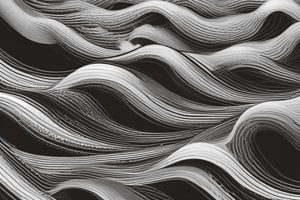Podcast
Questions and Answers
What is the direction of vibration in a transverse wave?
What is the direction of vibration in a transverse wave?
- At an angle to the direction of wave propagation
- Perpendicular to the direction of wave propagation (correct)
- Parallel to the direction of wave propagation
- In the same direction as the wave propagation
What is an example of a mechanical transverse wave?
What is an example of a mechanical transverse wave?
- Water wave (correct)
- Light wave
- Electromagnetic wave
- Seismic wave
What is the distance between two consecutive points on a wave that are in phase with each other?
What is the distance between two consecutive points on a wave that are in phase with each other?
- Frequency
- Amplitude
- Speed
- Wavelength (correct)
What type of wave can travel through a vacuum?
What type of wave can travel through a vacuum?
What is the maximum displacement of a wave from its equilibrium position?
What is the maximum displacement of a wave from its equilibrium position?
What type of transverse wave has vibrations that occur in a single plane?
What type of transverse wave has vibrations that occur in a single plane?
Flashcards are hidden until you start studying
Study Notes
Characteristics of Transverse Waves
- Direction of vibration: Perpendicular to the direction of wave propagation
- Motion of particles: Particles oscillate up and down, or side to side, creating a series of compressions and rarefactions
- Polarization: Transverse waves can be polarized, meaning their vibrations occur in a single plane
Examples of Transverse Waves
- Light waves: Electromagnetic waves that can travel through a vacuum
- Water waves: Ripples on the surface of water, caused by wind or other disturbances
- Seismic waves: Waves generated by earthquakes that travel through the Earth's interior
- Vibrations on a string: Transverse waves can be produced by plucking a guitar string or a violin string
Properties of Transverse Waves
- Wavelength: The distance between two consecutive points on the wave that are in phase with each other
- Frequency: The number of oscillations or cycles per second
- Speed: The distance traveled by the wave per unit time
- Amplitude: The maximum displacement of the wave from its equilibrium position
Types of Transverse Waves
- Mechanical transverse waves: Require a physical medium to propagate, such as water or a string
- Electromagnetic transverse waves: Can travel through a vacuum, such as light waves
- Polarized transverse waves: Vibrations occur in a single plane, such as linearly polarized light
Characteristics of Transverse Waves
- Direction of vibration is perpendicular to the direction of wave propagation
- Particles oscillate up and down, or side to side, creating a series of compressions and rarefactions
- Transverse waves can be polarized, meaning their vibrations occur in a single plane
Examples of Transverse Waves
- Light waves are electromagnetic waves that can travel through a vacuum
- Water waves are ripples on the surface of water, caused by wind or other disturbances
- Seismic waves are waves generated by earthquakes that travel through the Earth's interior
- Vibrations on a string can be produced by plucking a guitar string or a violin string
Properties of Transverse Waves
- Wavelength is the distance between two consecutive points on the wave that are in phase with each other
- Frequency is the number of oscillations or cycles per second
- Speed is the distance traveled by the wave per unit time
- Amplitude is the maximum displacement of the wave from its equilibrium position
Types of Transverse Waves
- Mechanical transverse waves require a physical medium to propagate, such as water or a string
- Electromagnetic transverse waves can travel through a vacuum, such as light waves
- Polarized transverse waves vibrate in a single plane, such as linearly polarized light
Studying That Suits You
Use AI to generate personalized quizzes and flashcards to suit your learning preferences.




